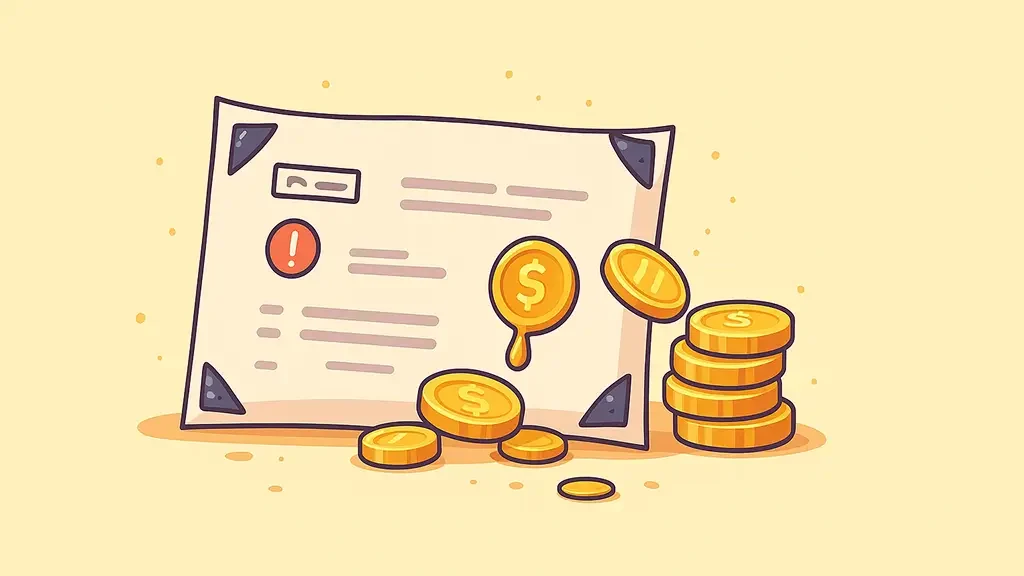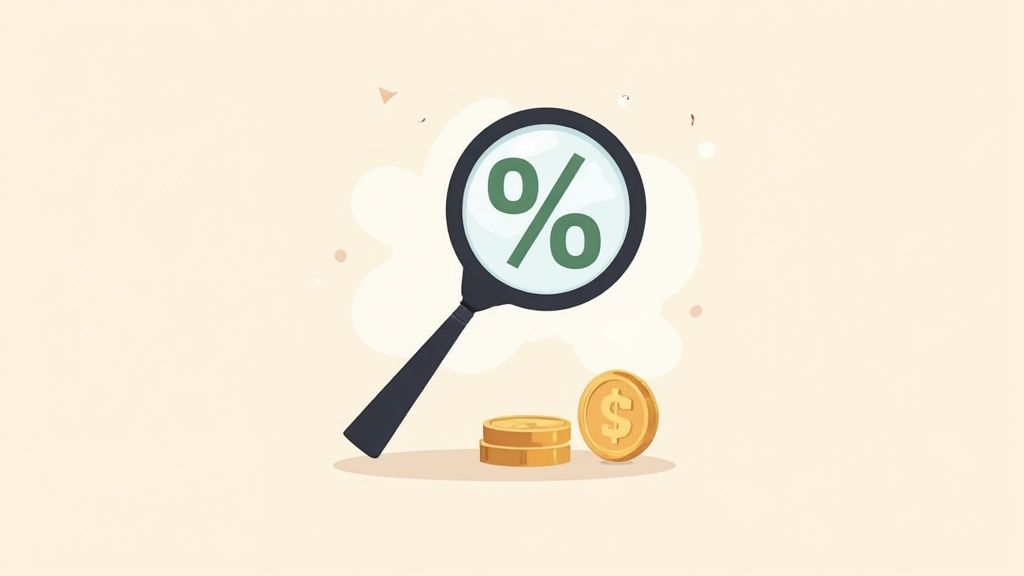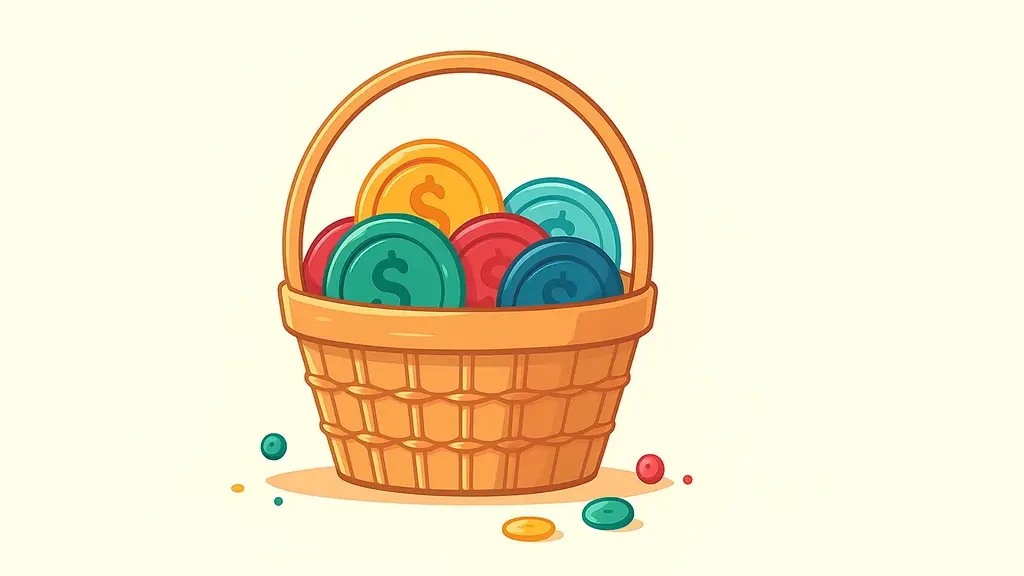How to Choose Dividend Stocks: Expert Tips for Investors
Learn how to choose dividend stocks with our proven strategies. Discover tips to analyze yields, safety, and company health for reliable income.

When you're picking dividend stocks, your focus should be on a few key things: a sustainable yield, a track record of consistent dividend growth, and solid company fundamentals like a low payout ratio. This approach isn't just about collecting checks; it's a strategy that blends steady income with the potential for stock appreciation, creating a powerful engine for long-term wealth.
Building Your Portfolio with Dividend Stocks

Building real wealth often starts with a simple, powerful engine: dividends. This isn't just about pocketing a small cash payment every quarter. It's a foundational strategy that fuels long-term growth and can bring a much-needed sense of financial stability.
Having a steady stream of income from high-quality companies helps you navigate the market's inevitable ups and downs with more confidence. That’s why dividend investing is a cornerstone strategy for everyone, from young investors just getting started to those mapping out their retirement years.
The Compounding Power of Dividends
The real magic of dividend investing lies in the total return—the powerful combination of regular income and the stock's price appreciation. When you take those dividend payments and reinvest them, you kickstart a compounding cycle. Each new share you buy with a dividend payment starts generating its own dividends, which can seriously accelerate your portfolio's growth over time.
This dual-engine approach of income and growth is a proven method for building wealth. History backs this up. Dividends have been a massive component of overall market returns. In fact, historical data shows that dividends have contributed to roughly 31% of the total return in the S&P 500 over nearly a century.
By focusing on companies that not only pay but consistently grow their dividends, you're investing in businesses with strong financial health and a clear commitment to their shareholders. It's a disciplined approach that helps build a resilient portfolio.
Creating a Stable Income Stream
For anyone looking to generate passive income, dividend stocks are a natural fit. This is especially true for those nearing or in retirement, where this income can supplement other sources. As you explore the best investments for retirement income, you'll see how dividend stocks play a crucial role in a broader, more comprehensive plan.
But a dividend portfolio isn't just about the income. It's also a fundamental part of a well-rounded investment strategy. As you pick individual dividend stocks, remember they need to fit within a larger, diversified framework to manage risk effectively. To dig deeper into this critical concept, check out our guide on how to diversify your investment portfolio. This ensures that a downturn in one sector won't derail your entire financial plan.
Look Beyond High Yields to Avoid Value Traps

It’s tempting, I get it. You're scrolling through stock screeners and a company with a 10% or 12% dividend yield pops up. It feels like hitting the jackpot. But I’ve learned the hard way that an unusually high yield is rarely a bargain. More often than not, it's a giant red flag.
This is what we call a "yield trap." It happens when a company's stock price tanks because of serious, fundamental problems. Since the yield is just the annual dividend divided by the stock price, a falling price automatically inflates the yield percentage. Investors who chase that flashy number often get burned twice: the company eventually cuts or eliminates the dividend, and the stock price continues to slide.
Context Is Everything
A dividend yield is meaningless on its own. You have to put it in context. A great first step is to benchmark it against its direct competitors and the broader industry. A utility company offering a 4% yield might be perfectly normal and healthy. But a tech company with that same 4% yield? That would be an outlier demanding a much closer look.
Another gut check I always do is compare the current yield to the company's own history. If a stock that has reliably yielded 3% for years suddenly spikes to 9%, it's a clear signal that the business is in trouble. The market is screaming that something has gone wrong, and the share price has collapsed as a result.
An outsized dividend yield often signals that the market has lost confidence in the company's ability to maintain that payout. The high yield is a reflection of high risk, not a high return.
To help you decode these signals, I've put together a quick table. Think of it as a cheat sheet for interpreting what a yield might be telling you.
Interpreting Dividend Yield Signals
This framework isn't foolproof, but it's a solid starting point for moving beyond just the headline number and thinking like a seasoned investor.
A Tale of Two Companies
Let's make this real. Imagine you're looking at two stocks.
Company A has a modest 2.5% dividend yield. But a quick look at its history shows it has raised that dividend every single year for the last decade. Its financials are rock-solid, and it operates in a stable industry.
Company B is flashing an 11% yield. But you dig a little deeper and see its stock price has cratered 60% over the past year because of declining sales and ballooning debt. The market is practically betting on a dividend cut.
Company A offers a reliable, growing income stream. Company B presents a huge risk of losing your initial investment and the dividend you were chasing. Smart dividend investing is all about finding more of Company A.
Finally, always benchmark against the entire market. The S&P 500's dividend yield is a fantastic baseline. For example, in mid-2025, the S&P 500's yield hovered around 1.25%. This is low compared to its historical average of about 2.88%, telling us a lot about current market conditions and recent stock price growth. You can explore more data on the S&P 500's historical dividend performance on gurufocus.com.
Confirming Dividend Safety with Key Metrics

A high dividend yield looks great on paper, but it means absolutely nothing if the company can't actually afford to pay it. Real dividend safety isn't found in a flashy percentage; it's buried in the company's financial statements. We need to look under the hood to see if that dividend is built on a solid foundation or just shaky ground, especially when the economy gets rough.
The first stop for most investors is the dividend payout ratio. It’s a straightforward calculation that shows what percentage of a company's net income is being sent out to shareholders. You find it by dividing the annual dividend per share by the company's earnings per share (EPS).
There's no single magic number here, but as a rule of thumb, I get cautious when the ratio drifts above 60%. A payout ratio climbing past 80% is often a red flag, suggesting the company is stretching its finances too thin. That leaves very little cash for reinvesting in the business, weathering a downturn, or, ironically, future dividend growth.
Why Cash Flow Is King
Here’s the thing: earnings can be manipulated with accounting tricks. That’s why I always put more weight on a different, more honest metric: the free cash flow (FCF) payout ratio.
Free cash flow is the actual cash a business generates after paying for operating expenses and capital expenditures (like new equipment or facilities). It's the real money left over to run the business and reward its owners.
A company with strong, rising free cash flow can comfortably fund its dividend, reinvest in growth, and weather economic storms. If you only look at one metric for dividend safety, make it this one.
To calculate the FCF payout ratio, you divide the total dividends paid by the company's free cash flow. A healthy ratio, ideally under 70%, gives me much stronger confidence that those dividend checks will keep hitting my account.
For a deeper dive into this kind of fundamental analysis, our complete guide on how to evaluate investment opportunities is a fantastic next step.
Real-World Application Comparing Two Companies
Let's make this tangible. Imagine two fictional consumer goods companies, "SteadySuds" and "FlashyClean."
- SteadySuds: Has a 55% earnings payout ratio and a 60% free cash flow payout ratio. Its cash generation is consistent and predictable, year after year.
- FlashyClean: Tries to lure you in with a higher yield, but its earnings payout ratio is 95%, and its FCF payout ratio is an alarming 110%. This means it's paying out more cash in dividends than it's actually generating. That’s completely unsustainable and almost always ends in a painful dividend cut.
The choice is obvious. SteadySuds offers a much safer dividend, even if its starting yield is a bit lower. It’s a classic tortoise-and-the-hare scenario.
Finally, always remember that payout ratios need to be viewed in their industry context. What’s normal for one sector is a danger sign in another.
- Real Estate Investment Trusts (REITs): These are a special case. They are legally required to pay out at least 90% of their taxable income, so a high payout ratio is not just normal—it's expected.
- Established Utilities: Companies in this space often have very stable and predictable cash flows. They can easily sustain higher payout ratios, sometimes in the 70-85% range.
- Fast-Growing Tech Companies: These businesses will usually have very low payout ratios, if they pay a dividend at all. They're plowing every available dollar back into the company to fuel aggressive growth.
By examining both earnings and—more importantly—free cash flow payout ratios within the correct industry framework, you get a much clearer, more reliable picture of a dividend's safety. This is the crucial step that helps you sidestep those tempting "yield traps" and build a portfolio of truly dependable income-producing stocks.
Finding Companies with Consistent Dividend Growth
A high starting yield is tempting, but it’s just a snapshot in time. The real magic for long-term wealth isn't the dividend you get today; it's the consistent growth of that dividend, year after year. This is where you shift your mindset from chasing a static income stream to building a growing one.
When you're figuring out how to pick dividend stocks, a long history of steady increases is one of the most powerful signals you can find. It points to a company with discipline, financial strength, and a culture that truly values its shareholders. Think about it: a company that keeps raising its dividend is essentially telling you its management is confident about the future.
The Power of Dividend Growth Aristocrats
To find these reliable growers, savvy investors often start with elite lists like the Dividend Aristocrats and Dividend Kings. These aren't just fancy marketing terms; they represent companies that have met incredibly high standards for dividend growth.
- Dividend Aristocrats: These are S&P 500 companies that have increased their dividend for at least 25 consecutive years. This list is a fantastic hunting ground for identifying high-quality, stable businesses.
- Dividend Kings: This is an even more exclusive club. To earn this title, a company must have raised its dividend for 50 or more consecutive years, proving incredible resilience and longevity.
Here's a look at the S&P 500 Dividend Aristocrats, which shows just how diverse these top-tier companies are.

As you can see, these reliable dividend payers aren't just clustered in one boring sector. They span industries from consumer staples and industrials to healthcare and financials, giving you plenty of options for building a diversified portfolio.
Focusing on companies with a long track record of dividend growth is a strategy built on evidence, not speculation. It aligns your investments with businesses that have proven they can prosper through multiple economic cycles.
Compounding in Action: A Tale of Two Stocks
Let's break down why growth almost always beats a high starting yield over the long haul. Imagine you have $10,000 to invest in one of two stocks.
At first glance, Stock B seems like the clear winner, paying out double the income in Year 1. But the power of consistent growth quickly changes the story.
By year 10, Stock A's annual income has already surpassed Stock B's. Fast forward to year 20, and it’s paying out more than double. This is the awesome power of compounding at work.
This effect, known as yield on cost, shows how the yield on your original investment can balloon over time. For Stock A, the yield on your initial $10,000 investment would be a whopping 14% after 20 years. This is the core reason why prioritizing dividend growth is such a superior long-term strategy.
Assess Company Health and Competitive Strength
A dividend is nothing more than a promise from a company to its shareholders. Before you bank on that promise, you need to be confident the company itself is built to last. This means looking past the shiny dividend stats and digging into the health and resilience of the core business.
Let's be clear: a great dividend from a weak company is a ticking time bomb. That’s why a huge part of choosing dividend stocks is good old-fashioned fundamental analysis. You’re looking for businesses that can not only survive tough economic patches but actually thrive through them, securing your income stream for the long haul.
Looking for an Economic Moat
One of the most powerful ideas in long-term investing comes from Warren Buffett: the "economic moat." Think of it like a real moat protecting a castle. It’s a durable competitive advantage that shields a company from rivals.
This advantage is what allows a company to protect its profitability and market share over decades. For a dividend investor, that's pure gold. A wide moat makes a company's dividend far more secure and predictable.
So, what does an economic moat look like in the real world? It usually shows up in one of these forms:
- Brand Loyalty: Think Coca-Cola. People happily pay more for a Coke than a generic store brand. That loyalty creates incredibly predictable cash flow.
- Patents & IP: This is the lifeblood of many pharmaceutical and tech companies. Legal protections give them a temporary monopoly, allowing them to earn outsized profits.
- High Switching Costs: Ever tried moving all your accounts from one bank to another? It’s a pain. That inconvenience is a moat. The same goes for complex enterprise software where switching is too costly or disruptive.
- Network Effects: This is when a service becomes more valuable as more people use it. Credit card networks like Visa and Mastercard are classic examples—the more merchants that accept them, the more valuable they are to cardholders, and vice versa.
When a company has a wide economic moat, its profits are better protected. That stability translates directly into a more reliable and sustainable dividend payment for you.
Analyzing the Financial Statements
Beyond the big-picture moat, you have to get your hands dirty with the numbers. This means a quick review of the company's financial statements.
First, look at the balance sheet to check its debt levels. A company drowning in debt is a red flag. Interest payments can easily chew through the cash that would otherwise go to your dividend.
Next, flip to the income statement. You aren’t looking for flashy, one-off earnings spikes. What you want is a history of steady, predictable growth in both revenue and profit. That kind of consistency is the hallmark of a well-managed, durable business.
Combining this company-specific analysis with a solid grasp of the bigger picture is crucial. If you need to sharpen your skills here, our guide on how to analyze market trends is a great place to build that foundation.
For instance, companies like Medtronic and Lockheed Martin are great real-world examples. Medtronic, a medical device giant, has raised its dividend for 46 consecutive years while keeping its payout ratio in a healthy range. Likewise, the aerospace leader Lockheed Martin recently boosted its dividend by 5%, backed by its unshakeable industry position.
As you can see from these top US dividend stocks from Morningstar.com, the best dividend investments always connect consistent financial performance and smart payout policies with a stable, defensible business model.
Of course. Here is the rewritten section, following the specified human-like style, tone, and formatting.
Common Questions on Dividend Investing
As you get your feet wet with dividend investing, a few questions always seem to pop up. It’s natural. Getting these cleared up is key to building the confidence to put these strategies into practice. Let's tackle some of the most common ones I hear from investors.
How Many Dividend Stocks Should I Own?
There's no single magic number, but a great rule of thumb is to build a portfolio with 15 to 30 individual dividend stocks. This range usually gives you enough diversification to spread your risk across different industries and sectors.
Why that number? If one company unexpectedly hits a rough patch and cuts its dividend, a diversified portfolio can absorb the shock. Owning fewer than 15 stocks concentrates your risk too much—a single bad apple can really spoil the bunch. On the flip side, trying to manage more than 30 can get overwhelming fast, making it tough to keep up with the research for each company.
Think of it like building a championship sports team. You wouldn't stake your entire season on one star player. A deep bench with strength across every position gives you a much better shot at winning consistently, year after year.
Are Dividend Stocks a Good Choice for Young Investors?
Absolutely. People often think of dividend stocks as just for retirees, but they are an incredibly powerful tool for younger investors. The reason is simple: you have a long runway for compounding to do its thing.
When you're young, you have decades ahead of you to reinvest every single dividend payout. This process, which can be automated through a DRIP, lets you buy more shares of a company without lifting a finger. Those new shares then start earning their own dividends, kicking off an exponential growth snowball that can lead to a much, much larger portfolio by the time you're ready to retire. It's a fantastic way to build a solid foundation of quality, cash-generating assets early on.
What Is a DRIP and Should I Use One?
DRIP is short for Dividend Reinvestment Plan. It’s a simple feature most brokerages offer that automatically uses the cash dividends you receive to buy more shares of the exact same stock.
One of the best parts? These purchases are often for fractional shares and happen without any commission fees.
For any investor focused on long-term growth, turning on a DRIP is one of the most effective "set-it-and-forget-it" moves you can make. It automates compounding, putting your returns back to work immediately so your money is never sitting idle. You accelerate your portfolio's growth without having to track payout dates and manually place new trades.
What Are Qualified Dividends and Why Do They Matter?
This is a big one, especially if you're investing in a regular taxable brokerage account. Qualified dividends are payouts that get special tax treatment—they're taxed at the lower long-term capital gains rate instead of your higher, ordinary income tax rate.
So, how does a dividend get "qualified"? You generally need to hold the stock for a minimum period around its ex-dividend date (typically more than 60 days). For most of us holding stocks from major U.S. companies for the long haul, our dividends will almost always be qualified. Focusing on these can lead to significant tax savings over time, letting you keep more of your hard-earned investment income.
Ready to put these principles into action? With PinkLion, you can track your dividend income, forecast future cash flow, and stress-test your portfolio to ensure your chosen stocks are as resilient as they seem. Stop guessing and start making data-driven decisions. Explore all of PinkLion's features and start for free today.
